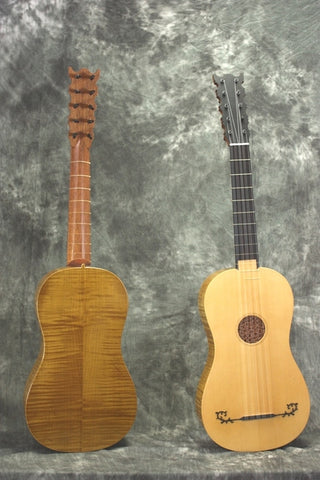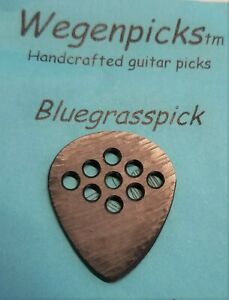History of Guitar Picks: Origins & Evolution
June 11, 2024
The relationship between the stringed instrument and guitar picks or plectrums in general goes as far back as recorded history allows us to see,
and they don’t appear to be going anywhere anytime soon.
Over the generations, their appearance have come in all shapes, sizes and materials yet have always served the same purpose,
to strike the strings of an instrument in order to produce sound.
Related: History of guitar standard E tuning
Ancient times
The Lyre was a harp style instrument that was popular in Ancient Greece and Mesopotamia, the first depictions of it dating back to around 3000 BC.
It is thought to have originated in the Middle East, and it was used both for music and for storytelling.
The instrument was typically made from wood, with strings that were plucked or strummed.
Related: Each Guitar String Name

The sound of the lyre was said to be evocative and melancholy, and it was often used to accompany poetic recitations.
The instrument was also associated with the god Apollo, who was said to be an accomplished player.
In addition to being a symbol of Apollo, the lyre came to represent harmony and balance, due to its pleasing sound.
The instrument remains an important part of Greek culture today, and it is still played in traditional settings.
The plectrums of this kind were crafted from carved wood, goats horn, and animal bones and were flat or round in shape.
The plectrums were used to create many spectacular and idiosyncratic sonorities and techniques including but not limited to: harmonics, buzzing, string stopping, portamentos, tremolo, and creating microtones.
Not only that, but they were latched onto a leather string that hung from the lyre, which means they never worried about losing their picks!
The Ancient Greeks truly were advanced!
Middle Ages & Renaissance
The Oud
The Oud is a traditional stringed instrument that has been used in Middle Eastern music for centuries.
Its is wooden, hollow, and pear shaped. Think of it as the Renaissance lutes big brother.
One of the most distinctive features of the oud is its sound, which has been described as "otherworldly" and "haunting."
It is non-fretted and derives its distinct aura from the usage of microtones, something us westerners are daunted by because our ears are not accustomed to deciphering such tones.

The unique sound of the oud is also generated by the usage of a plectrum. The plectra are (in most countries) called Risha, meaning feather.
Initially eagles feathers and quills were used to pluck strings, but nowadays plastic and wood materials are used more.
The plectrum is used to pluck the strings of the oud, and the specific way in which it is done produces the instrument's characteristic sound.
There are a few different ways to hold a plectrum when playing the oud.
The most common is to hold it between the thumb and first two fingers, with the point of the plectrum protruding from between the index and middle fingers.
This grip gives the player good control over the plectrum, and allows for a wide range of picking techniques.

Another way to hold the plectrum is to hold it between the thumb and first finger, with the point of the plectrum protruding from beneath the middle finger.
This grip is often used for fast, intricate picking patterns. Its unique sound has made it one of the most popular instruments in the Middle East.
Today the Oud is widespread across the Mediterranean, The Middle East, and Northern Africa.
The Medieval & Renaissance Style Lute
The Lute was introduced to Europe by the Moors in 700-800 AD.At the time the lute was predominantly used to play one line melodies in accompaniment with singers or other instrumentalists.

They decided to add frets and extra strings to the instrument and maintained the tradition of using a quill plectrum,
however in the midst of the Renaissance era (1400-1600) they dropped the plectrum for the fingers, to take advantage of the lutes polyphonic qualities.
That is, the ability for one instrument and one player to play musical pieces with multiple voices simultaneously.

The lute became the perfect independent instrument, capable of playing entire solo pieces.
This marked the rise of contrapuntal and chordal playing.
The Vihuela
The first recorded use of a guitar pick as we know it dates back to the 13th century, when an instrument known as the vihuela was played in Spain.
The Spanish vihuela was a plucked string instrument with a wide, flat body and a long neck, it is thought to be the predecessor of the modern guitar.
It was used in Spain during the 15th and 16th centuries and was particularly popular in the courts of the nobility.

The vihuela was similar in size and shape to the modern-day guitar, but it had a shorter neck and only five strings.
It was played with the fingers or with a small plectrum, and it was often used as an accompanying instrument for singers and dancers.
The Spanish vihuela fell out of popularity in the 17th century, but it has been revived in recent years by some contemporary musicians.
The vihuela was strummed with the fingers, but picks were sometimes used to produce a brighter, more percussive sound.
1900’s to Modern Days
Picks became more popular in the 19th century with the development of the guitar.The first mass-produced guitar picks were made from celluloid, a type of plastic.
Celluloid was first introduced in the 1870s, and it quickly became the material of choice for all types of guitar picks due to its durability and ability to be molded into various shapes, not to mention it was relatively cheap to produce and still is to this day making them accessible to all.
The D’Andrea 351
was the first celluloid guitar pick ever made.
Luigi D’Andrea was no musician, but a clever man from Italy, looking to make some big bucks in the United States.
Walking down a Manhattan Street, he sees some overstocked celluloid and other inexpensive materials being sold in the window of a manufacturing company.
Given a spark of inspiration he decides to purchase the materials.
Funnily enough, It appears Mr. D’Andrea’s initial intention was not to make guitar picks from the excess materials, but to make womens makeup compacts!
It wasn’t until, having chiseled the celluloid into pretty heart shapes that his 8 year old son declared how they looked like the picks he’d seen being played by mandolin players.
Luigi and little Tony then march to the local music shop and sell the first celluloid guitar picks for a whopping $10.
Not even D’Andrea knew there could be a market for plastic picks.
Nobody could preconceive the bloom of the Jazz era that demanded such picks for their distinct sound and techniques nor could they predict the later banning of all items crafted from the shells of turtles.
The 351 rose to fame and celluloid became the most common material for all types of guitar picks.
Jazz/ swing
Along with the jazz era came new techniques and styles of playing, never before interpreted by the human ear.
These new styles came to be as the usage of guitar picks became constant among players.
They also aided in amplification against other band instruments.

Jazzer and big band guitarist Freddie Green utilized his plectrum to create new rhythm styles that kept dancers on their toes.
Among these styles is the iconic four to the bar technique, where he would play four evenly-spaced chords per measure, creating a steady rhythm that became one of the hallmarks of the Basie sound.
Green's playing was an important part of the 'Big Band' sound of the 1930s and 40s, and he continued to perform with the Basie orchestra until his death in 1987.
Today, Green is considered to be one of the most influential jazz guitarists of all time.
Django Reinhardt was a Belgian-born Romani jazz guitarist and composer who rose to prominence in the 1930s.
He was one of the first guitarists to make use of the new style of guitar playing known as la pompe, or "the pump."
This technique involves rapidly alternating between two chords while simultaneously strumming the strings with a pick.
This style requires a quick rake and chuck with the right hand, with left hand muting.
Django was able to execute this difficult technique with seeming ease, and it soon became one of his trademarks.
One of Django's original picks, owned by Martin Taylor
While Django's la pompe technique is admittedly impressive, it is just one aspect of his guitar playing that sets him apart from other musicians.
His unique style, which blends elements of Gypsy music with jazz and blues, has inspired generations of guitarists and continues to influence music today.
Bluegrass music
is known for its fast, intricate melodies and often features extended solos.A key part of this sound is the flatpicking technique, which involves using a pick to play individual notes on the guitar.

This style of playing was popularized by pioneers like Doc Watson and Merle Travis, and today it is an essential part of bluegrass music.
While flatpicking can be challenging, it is also extremely rewarding, producing a bright, clear sound that can really make a song come alive.
If you're interested in learning how to play bluegrass guitar, flatpicking is a great place to start.
Rock & Heavy Metal
When it comes to metal music, a guitar pick is essential.
The hard edges of the pick help to create the signature sound of metal, and the sharp attacks of the pick add to the intensity of the music.
Related: Best guitar picks for metal music
Source: Is the Jazz III the ultimate lead guitar pick?
The pick also helps to create a consistent tone, which is important in metal music where precision is key. In addition, the pick helps to prevent string breakage, which can be a problem when playing metal music with heavy distortion.
As a result, using a guitar pick is a must-have for playing most rock & metal music.
Iron Age Guitar Picks
The Almighty Iron Age pick, started by none other than Alex himself, when he was just a wee lad and needed to make money to eat food.
Our picks are designed to give you a unique advantage over traditional picks.
Ease of utility, accuracy, and precision are all effects experienced by those who use our picks.
If you want to understand what elements go into achieving these enhancements or need help deciding what pick will benefit you most please read our ultimate guide on guitar picks.
As you can see, handcrafted plectrums have a long history that dates back to antiquity.
Since 2015 Iron Age has been keeping the tradition alive, so that musicians can continue to make history and achieve perfect creative expression with an air of style, identity, and individuality.
Which make them perfect for those who wish to personalize their sound, and stand out from the crowd.
Conclusion
Plectrums have been around for centuries, and their exact origins are unknown.Up until the 19th century, feather quills reigned supreme, being inexpensive and accessible to common folk.
If you were extra special perhaps you played a hand crafted plectrum of bone, wood or ivory.
If you played a parlor guitar in the 1800’s you likely owned a turtle shell guitar pick.
And if you were living amidst the boom of Jazz, swing or even rock and roll, perhaps you used shell or celluloid.
What does the future hold for the evolution of guitar playing, and will our descendants someday study the strange musical rituals of our time?
Do you remember the first time you ever held a pick?
Where were you and what year was it?
Let us know a little bit about your history with guitar picks below!
Regards,
Emma & The Iron Age Team
Also in Codex | General

Why Do Guitar Killswitches Pop & What You Can Do
November 29, 2025

Stand Triumphant: The Myth & Meaning of the Imperial Collection
November 20, 2025
Polished acrylic. Blue pearlescent depth. The Imperial Collection draws on ancient symbols—authority, discipline, restraint—to favor tone and control over brute strength. See the six roles inside...

Spec Changelog: July–December 2025
November 15, 2025
This is a running log of buyer-visible spec changes for Iron Age gear from July–December 2025. Picks, knobs, killswitches, and policies are listed by date with a short note on what changed, why, and what you might notice in use...

The Oath — How We Build & What We Stand Behind
November 12, 2025
Precision-crafted picks profiled by machine, voiced by hand. See what’s made in-house, what’s partnered, and the standards we hold—plus the oath we stand behind when shipping or wiring goes sideways.

The Sword & The Laurel: What Our Mark Demands
November 05, 2025
A sword ringed by laurels: will and earned peace in the palm of your hand. This is the creed behind our mark—and how it can ignite your next session. Begin again, on purpose...

Black Fingertips From Playing Guitar? What’s Really Going On
September 25, 2025
Noticed your fingertips turning black after playing guitar? From string chemistry to fretboard dyes and even the environment you play in, here’s what really causes it — and how to keep your hands (and gear) cleaner.
+Start Here
The Sword & Laurel — what our mark demands of the maker, and the musician.
The Oath — how we make, what’s in-house vs partnered, and what we stand behind.
+Featured
Be first to know when new picks drop. Blog updates & shop news, no noise.15% off for new subscribers.
+Choose Your Artifact
Gladiator · Imperial · Legio Ferrata · Parthenon · Ragnarok · Limited Edition · All Picks
+Affiliate Notice
As an Amazon Associate, Iron Age earns from qualifying purchases.
Iron Age Guitar Accessories
226 Douglas Way St
San Antonio, TX 78210
USA
⚔️
“Quality is never an accident. It is always the result of high intention, sincere effort, intelligent direction and skillful execution. It represents the wise choice of many alternatives.”
~William A. Foster (MOH Recipient, 1945)
- Contact
- The Oath
- Sword & Laurel
- About
- Shipping Info
- Returns & Warranty
- Account
- Rewards
- Endorsement
- Wholesale
- Privacy
- Terms
Sign up for the Iron Age newsletter to Save 15% on your 1st order, plus get exclusive offers, product updates, and early access to giveaways!
© 2025 Iron Age Guitar Accessories.
Est 2015.

